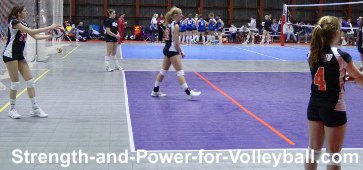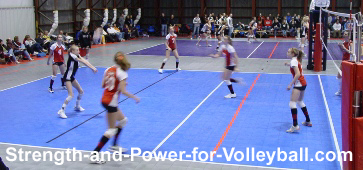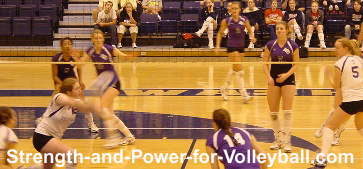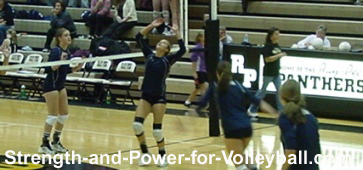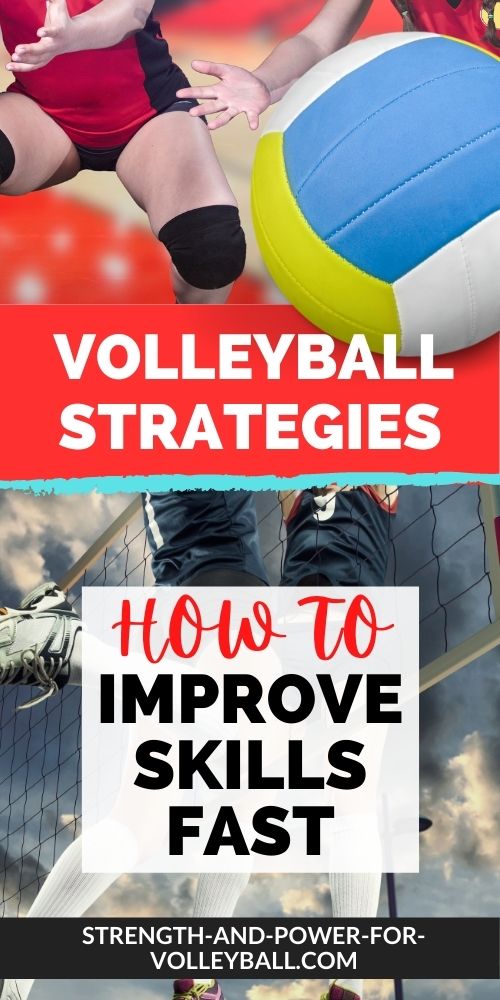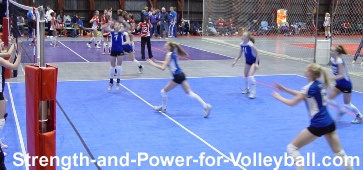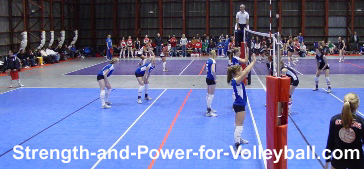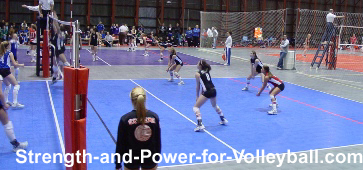Volleyball Strategies
Tactics for Skill Execution
Along with enhancing volleyball skills, developing volleyball strategies is an important part to team success.
Serving
Have a philosophy. Whether your philosophy is to serve aggressive or more conservative, you need to have a serving philosophy that will enhance your chances of winning at the level you are competing.
The best servers realize the importance of serving skills. For a moment, the server has complete control of the game. To a degree, their serve dictates how the rally is going to be played out.
I think many coaches don't take serving seriously. Most players serving skills aren't as good as they should be. Serving is a skill that a player has complete control over. Being able to put on a tough serve is a skill players can't afford to not develop.
Learn to serve under pressure. Serving repetitively in practice gives your players a chance to better the skill, but it doesn't give them the experience and pressure of game situations.
Some serving volleyball strategies for learning to serve under pressure...
- Find a way to pressure your servers in practice. Play scrimmage in practice and keep score. Penalize a team or individual players for missing serves or for not serving tough enough.
- Keep the pressure on your servers in every match. Every team at some point plays opponents that are under matched. Use this as an opportunity to work on serving.All too often I see players lose focus and not care how they serve. Even though it may appear you are going to win easily, by using this time to put the pressure on your servers, they'll be ready for when it really counts.
Serving is probably the most under developed skill in volleyball. Every team should develop serving strategies. There's no better way of taking control of a game than with an unstoppable server.
Passing
Passing tough floaters. Common volleyball strategies for passing include having players try and cradle the ball on their arms when they pass, thinking players can get better control of tough floaters the longer the ball stays on their arms.
Although this is usually a good idea, it may be better to be more aggressive when passing, particularly if the ball is floating well.
I like to think of it as, you playing the ball, instead of the ball playing you.
Passing with your hands or forearms? I thing taking the ball with your hands instead of your forearms on serve receive and other first ball contacts is a good idea in certain situations.
Some good volleyball strategies for using your hands are...
- Control the ball with your hands, and don't worry about doubling.Seeing as though it's legal to double contact on the first ball, players can be taught to take this first ball with their hands in a more controlled manner by intentionally doubling it for a more control pass.
- It's usually easier to take hard driven balls (especially deep serves) with your hands than trying to forearm pass them.
The bad thing about using your hands...
- It can sometimes be tough to take a good floater with your hands. Moving sideways to pass a ball with your hands can be pretty difficult. Also, sometimes you can get caught in deciding between using your hands or forearms to pass. This is a decision that you have just a split-second to make. This is why I think it's a good idea to know before a server even serves whether you have given yourself the option to use your hands or not.If the server has served balls that were too tough to pass with your hands in the past, it might be a good idea to commit to using your forearms to pass before they even serve.
Serving volleyball strategies for good placement are...
- If you're playing against a passer that is short and doesn't like using their hands for passing, serve deep.
- If you are playing against a passer that is tall and likes to take everything with their hands, serve short.
Keep your eyes on the ball all the way to your arms. It's tempting to watch the ball with your peripheral vision when passing.
The best volleyball strategies teach passers to follow the ball all the way onto their arms. Although it takes discipline if you aren't used to it, following the ball all the way does make a difference.
Setting
Setter footwork is important. Many coaches don't care about their setter's footwork and just focus on getting the setter squared and in position to set. I think this is a mistake.
Just like with other skills, consistent technique brings consistent results. Coaches should develop volleyball strategies for better setting involving footwork and ball handling.
By having consistent footwork, (for example, always have your right foot a little further in front of your left when squaring up) allows for more consistent sets.
Setting volleyball strategies for better accuracy. Also, there is a simple footwork technique that can be applied when a setter is moving from the target position to where the pass is going.
The setter can take a big right step to the spot where the pass is going, pivot on the right foot turning to square up to where they are setting the ball to.
Set tighter or further off simply by adjusting the position of the right foot. If a setter is having trouble keeping their sets off the net, they can simply keep their right foot out in front of them a little bit more than usual.
This will open up their body to the court a little bit which will result in setting further off. On the other hand, if they are having trouble setting too far off, bring that right foot back (by continuing the pivot) closer to a neutral position.
Attacking
Strategies for attacking involve learning many different types of hits and shots. Attackers footwork is often a controversial topic.
Approaching at one speed versus quick last steps. Many volleyball strategies for approaching just emphasize taking fast steps. This may be good for when first teaching volleyball players the approach, but more experienced players need to have a quick last couple steps.
By having your last steps be quicker than your previous steps, you will better utilize the stretch shortening cycle and stretch reflex of your muscles and nervous system therefore increasing your jump and quickness.
If you enjoyed these tips and would like to keep it close to you at any time, just save this pin to your Pinterest Volleyball Training Board.
Should attackers try to change their steps if they are a wrong-footer? Volleyball strategies for footwork include deciding if it's necessary to correct attackers footwork.
Changing an attackers footwork is probably the hardest skill in volleyball to change.
If you're successful attacking with how your steps are now, it may not be worth the hassle. Obviously, the sooner you start to make the change, the easier it will be.
Making the change really comes down to how determined a player is. If a player is still fairly inexperienced, it will probably be easier for them to switch the steps because of they have a less developed motor pattern of movement (not as strong of a habit to change).
Advantages of a wrong-footed approach. Right handed hitters that are wrong-footed (also known as goofy-footed) may be better at hitting down the line on the left side.
After stepping right-left-right on the left side, your body is facing more square to the net. Since it's usually easier to hit the direction you're facing, wrong footer's may be more comfortable hitting down the line on their strong side rather than having to turn or cut back angle.
Wrong-footers often have the appearance of jumping really well. Since they're not in the best position to hit after they jump, they spend more time adjusting while in the air.
This extra time they take to adjust their body position makes it appear they jump higher than they actually do. It's really just a greater amount of hang time before they hit.
This is a reason why it's often harder to block wrong-footers, because it's hard to get a read on their body position and the extra time in the air can throw off a blockers timing.
Disadvantages of a wrong-footed approach. I think the biggest disadvantage to being a wrong-footer is the added importance of having to get to the best spot on the court to jump and hit from.
For example, when approaching correctly, a hitter has the ability to float or drift to the ball if they need to. Their take-off point isn't as important.
So a wrong-footer needs a better read on the ball coming from their setter because it's more critical where they jump to hit from.
Blocking
Most volleyball strategies for blocking can be divided between two concepts, area blocking and read blocking.
Area blocking. Area blocking is when the blockers have predetermine what area they are going to take away from the hitters.
Blocking strategy usually consists of taking away the oppositions most likely shot (area they are most likely going to hit to) with the defense covering the other area of the court.
Read blocking. Teams with bigger blockers and not so great defensive players may use the strategy of read blocking.
With this strategy, blockers are allowed to try and read the hitters during the attack. Blocking decisions are made on the fly and where a blocker is going to block can be unpredictable.
Obviously this is good that your opponents dont know what you're blocking, but a lot of times neither do your defenders.
Ready position for blocking. Blocking volleyball strategies should include more than just standing at the net with your hands in the air.
Blockers should be in an athletic stance ready to move. They don't just need to be ready to block.
Blockers need to be ready to...
- Hit an overpass
- Pull off and pass an overpass
- Move to block the setters attack hit or dump
- Pull off the net and be ready to be set in transition
Digging
Good volleyball strategies for digging include expecting the ball, reading the hitter, and focusing on playing the ball to your target.
Expect the ball to be hit to you. By expecting the ball to be hit your way, you will be ready to play every ball.
Digging often takes more concentration than passing. You have less time to react and the ball is coming faster. Good volleyball strategies involve anticipating that you will be the one playing the ball to allow better focus on making a successful play.
Read the hitter, but don't cheat. Watch the hitter for clues of what they are going to do with the ball; swing hard, hit a cut shot, tip, etc. You don't need to guess.
With practice you will be able to run down their shots without cheating.
Don't just play the ball; pass it to your target. We often get in awkward positions when making defensive plays. It's easy to get in the habit of just trying to get the ball up.
Really focus on passing to the spot that would be best for that particular play.
Play the ball with two arms if possible. Sometimes you get caught in awkward positions trying to make a defensive play.
Even though it's good to try and make a one arm dig if you have to, the best volleyball strategies involve getting two arms on the ball if possible.
Volleyball Strategies Related Pages
Read the Block
See the block tips for spiking around the block. How to see blockers and get an advantage spiking the volleyball. Tips for tooling the block and seeing the court.
How to Pass the Floater
How to pass a float serve in volleyball. Discover my tips for passing the floater. Anticipation and reading the server. How to serve receive floaters. Passing tips.
Tactics for Winning
Tactics in volleyball for playing smarter and making better decisions to help your team win. Tactics for serving, defense, setting, and attacking will help you
Blocking Strategies and Tactics
Blocking strategy and tactics that keep your team one step ahead of the opponent. Nothing frustrates hitters more than...
Hitting Smarter
Volleyball attacking strategies for mastering hitting an array of shots to all areas of the court, sidelines, endlines, problems for defenders...
Serving Strategies
Serving strategy for taking the opponent out of system and adding pressure to the serve receive. Being deceptive and learning...
Anticipation
Follow these tips to improve anticipation skills. Learn to make plays easier by anticipating the play. Getting in position is much easier if you read...
Serving Short
Serving short and other strategies for serving in volleyball. Mens game versus the womens game. Should you signal the server? In the women's game, signaling the server...
Serving... 7 Common Mental Mistakes
Volleyball server types and strategies for smarter serving. There are seven common serving mindset mistakes. Heave and hope, do or die, the fader, hot and cold, mechanical...
Smarter Volleyball using Your Height to Your Advantage
Play volleyball at any height. Do you think you're too short to play volleyball? There are many advantages to being a shorter player.
Playing Out of Your Mind
Have you heard the phrases, he's unconscious, or playing in the zone? Use mental training techniques to get your team playing at their best all the time...
Winning
Winning at volleyball by being consistent, making adjustments, and building momentum are keys to winning in volleyball. Mental training...
Doubles
Doubles volleyball should be seen as a way of training for sixes. If you play doubles, you have the opportunity to learn many things that will improve...
Serving... Is it Really that Important?
Volleyball serving is most underused skill in volleyball. Servers that just toss the ball up and serve to put the ball into play are missing a golden...
Rotational Defense
Rotational defense for volleyball is a very popular defensive system used today by high level volleyball teams. What defense your team should use depends on the player's you've got and who you're playing...
Man Up Defense
Man up defense or red defense has become popular once again in high school and club volleyball. All defensive systems have built in advantages...
Transition
Tips for the transition from defense to offense. Great teams can swiftly and easily go from a great defensive dig to an awesome offensive attack. This is the transition game. Making a dynamic defensive play on a ball then...
Defending
The level of volleyball defense you play is influenced by how well you can anticipate and react to your opponents actions. Get an advantage by training...
4-2 Receive
A 4-2 serve receive offensive system is the most basic volleyball offense. In a 4-2, you have 4 attackers and 2 setters. Each setter sets when...
5-1 Receive
Volleyball serve receive for a 5-1 offense is much different than a 4-2 or 6-2 offense. In a 5-1, you have 5 attackers and just 1 setter. The setter sets...
6-2 Receive
Volleyball serve receive rotations for running a 6-2 offense is the most common volleyball offensive system. In a 6-2, you have 6 attackers and 2...
Strategies for Serving Floaters and Jumpers
There is no better way of taking control of a match than with tough serving. Volleyball strategies for serving include floaters, jump serves...
Strategies for Passing
Offensive tempo and team execution both are largely influenced by players ability to pass accurately. Strategies for passing...
Strategies for Setting
The setter is the most important position in volleyball because the setter is involved in almost every play. Setting strategies...
Strategies for Attacking
A volleyball player can develop many different volleyball strategies for attacking the ball. The key to an effective arm swing is...
Strategies for Blocking
Every team needs volleyball strategies for blocking. Blocking schemes vary from team to team. For some, the block is the primary method of defense...
Strategies for Digging
Good defensive teams force attacking errors by using volleyball strategies that wear down and frustrate their opponents. The key to great defense...
Defensive Positions
Defensive positions volleyball and tips for where to line up on defense. Back row players are important for digging and running down tips.
Plays to Run
Volleyball plays to run and the best offensive strategy for your volleyball team. 6-2 volleyball offense and 5-1 volleyball offense with volleyball tips.
Volleyball › Volleyball Strategies
- Home
- Strategies
